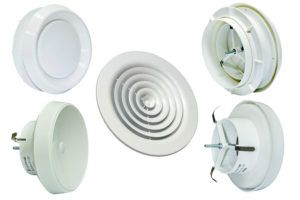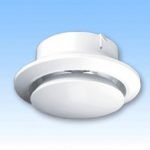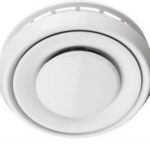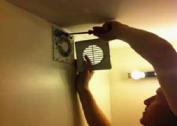We can say with great certainty that literally everyone is familiar with the lack of a standard and familiar air conditioner. In order to achieve an even distribution of chilled air in the room, you need to adjust the dampers long enough.
When using models with insufficient freedom of the blades, you have to put up with the fact that in one place of the room you can feel a noticeable cold air flow, and in the other it is relatively stuffy. This problem is solved by a ventilation anemostat, which shows very good results both with the use of ducted air conditioning systems, and supply and exhaust ventilation.
The purpose of the anemostat
 Anemostat performs one utilitarian function. Forms and distributes the flow of air entering the room or vice versa, leaving the ventilation system. Distinguish:
Anemostat performs one utilitarian function. Forms and distributes the flow of air entering the room or vice versa, leaving the ventilation system. Distinguish:
- exhaust intended for air intake from the room;
- supply, the task of which is to distribute the injected flow;
- universal, able to function effectively in hybrid ventilation systems.
Everyone knows the anemostat, this is a circular device consisting of a main body and a central head (divider plate), the position of which can be adjusted. Such a fixture is made of plastic, but there are models made of aluminum coated with powder or polymer coating.
Important notice. Exhaust, supply and universal type anemostat - different devices that differ structurally. Therefore, the installation of a supply anemostat in the exhaust ventilation leads to a very sharp decrease in the performance of the system (similarly, when the exhaust is installed in the discharge duct). A universal anemostat is a device of another class that combines design solutions of the other two types of devices.
What is the difference between anemostats
The main thing is the difference between devices for various purposes - the nature of the distribution of air masses. We describe the operation of the anemostat in simple words, for each of the three types.
- An anemostat designed for forced ventilation or air conditioning has such a configuration of the central part, in which, roughly speaking, the injected air is evenly distributed parallel to the surface on which the device is installed. The usual form of the divider is a concave plate on the outside.
- An anemostat designed for exhaust ventilation is able to take a significant flow of air that passes through it, almost without resistance. In this case, the shape of the central part is such that the air flow is absorbed in the form of a vertical cylinder (in the case of installing an anemostat on the ceiling). This ensures quick air exhaust from the center of the room.
- The universal anemostat has two divider plates. One works when exhaust ventilation is used, the second - when air is forced into the room. The selection of the appropriate mode is carried out manually by overlapping the currently unnecessary gap.
- Supply anemostat
- Exhaust anemostat
- Universal anemostat (supply and exhaust)
The amount of air that the anemostat passes through itself during ventilation is also very easy to adjust. Central plate - divider can change position, reduce or increase the technological gap.
How to install an anemostat
Installation instructions for the anemostat in ventilation systems look very simple:
- the device is mounted in a suspended ceiling panel or gypsum board;
- in the space between the suspension panels and the ceiling, air ducts are laid that lead either to a ducted air conditioner or to a separate fan;
- can be mounted with an air duct leading to the central ventilation duct.
No difficulties with installing anemostats usually arise. It is only necessary not to forget to bring your own air duct to everyone, this is especially important if the installation is done in a drywall plate.
A little trick. If desired, you can mount one long box of narrow section, which is closed on one side, and on the other - equipped with a supply or exhaust fan. By arranging anemostats along the length of the structure, each of which is adjusted depending on the distance of the ventilation source, it is possible to achieve a uniform intake or a smooth air flow along the entire length of the duct. This is a very convenient option if exhaust ventilation is done in a small kitchen, where there is only one outlet duct in the wall.
Conclusion
Anemostat is a simple and at the same time very functional device. Applied to both exhaust and discharge, as well as hybrid ventilation systems, it allows you to easily and clearly control the air flow, ensuring the desired temperature in the rooms and even in individual parts of the room. Due to the ability to capture and remove an almost vertical column of air, they are indispensable as a complete set of exhaust devices in areas of smoking, smoke, and pungent odors.





